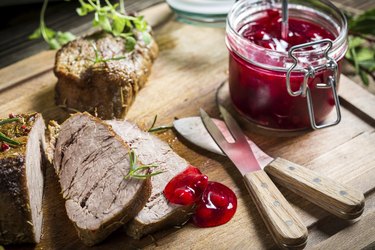
Farm-raised venison is an easy meat to like, a lean and flavorful alternative to beef that can be cooked in much the same way. Wild venison is more problematic, in part because it's often tough and can have a strong, gamy flavor. Much of the animal can be converted to cube steak by running it through a mechanical tenderizer, which solves the toughness issue, but removing the gamy flavor requires a few extra steps.
Kosher Your Cubes
Video of the Day
A wild-caught deer can taste gamy if it wasn't killed cleanly, because the same muscle compounds that fuel its flight when frightened give it an unpleasant flavor. So can its blood, if the carcass isn't bled properly before butchering. You can remove both of those causes of gaminess by soaking the cube steaks briefly in a mild brine, just as kosher butchers do. Dissolve 2 tablespoons of salt in 3 cups of cold water, and soak the cube steaks for three or four minutes. Drain the water and repeat the process another two or three times. Plain cold water will work, if you're watching your sodium, but a light brine is better.
Video of the Day
Using a Marinade
Marinating the venison is a similar technique to using brine, with the bonus that it provides an opportunity to add desirable flavors rather than just eliminating unpleasant ones. Classic venison marinades are usually based on red wine, with lots of aromatic ingredients such as onions, bay leaf and juniper berries. Feel free to use any combination you like. A small amount of oil in the marinade is useful, because some flavors are conducted better by fat than water. Cube steaks only require an hour or so in a marinade, because of their texture, so be aggressive with your seasoning. Alternatively, use buttermilk as a simple marinade that adds minimal flavor but provides additional tenderizing.
A New Coat
A buttermilk marinade is especially suitable if you like your venison cube steaks breaded, and treated as a cutlet or "chicken-fried" steak. It leaves the cube steaks with a mild flavor, and the residual tang of the buttermilk makes a suitable complement for the venison. The crisp coating of breadcrumbs adds to the pleasure of the dish with its golden color and textural contrast, as well as providing a pleasantly toasty taste to help mask any residual gaminess.
Cooking in Sauce
Another alternative is to cook the cube steaks in a strongly flavored sauce, where the gaminess of the venison contributes a dark and earthy note to the dish's final flavor profile. Cube steaks simmered in rich gravy or tomato-based sauce, braised in soy and ginger for an Asian taste or even slow-cooked in barbecue sauce can become a tender and comforting dish.
Several Ounces of Prevention
Other tricks minimize the gaminess of your venison before it ever reaches your stove. A clean killing shot is best, if not always possible. Once the animal is downed, bleed it and clean it as soon as possible for the most neutral flavor. If the outdoor temperature is above freezing, consider taking along picnic coolers with bags of crushed ice to fill and chill the carcass. Trim away as much fat, bone and tough connective tissue as possible -- or instruct your meat cutter to do it -- because all of those can bring a gamy taste to your cube steaks. Always cook venison steaks to an internal temperature of 160 degrees Fahrenheit.
- Texas Hunt Works: Removing Gamey Flavor
- Southern Indiana Butcher: Gamey or Wild Tasting Meat
- University of Minnesota Extension: Gamey Flavor and Cooking Venison
- Fine Cooking: Marinades Add Flavor but Don't Always Tenderize
- The New York Times: Turning to Cube Steak, and Back to Childhood
- U.S. Department of Agriculture Food Safety and Inspection Service: Game From Farm to Table